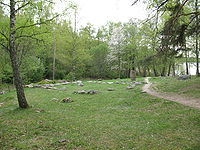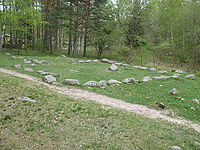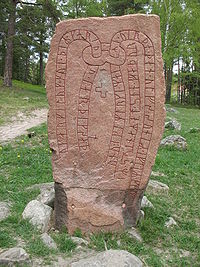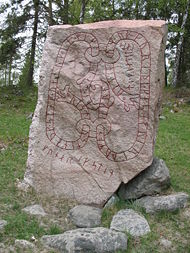
Arkils tingstad
Encyclopedia


Viking Age
Viking Age is the term for the period in European history, especially Northern European and Scandinavian history, spanning the late 8th to 11th centuries. Scandinavian Vikings explored Europe by its oceans and rivers through trade and warfare. The Vikings also reached Iceland, Greenland,...
thing
Thing (assembly)
A thing was the governing assembly in Germanic and introduced into some Celtic societies, made up of the free people of the community and presided by lawspeakers, meeting in a place called a thingstead...
or assembly location of a hundred in Uppland
Uppland
Uppland is a historical province or landskap on the eastern coast of Sweden, just north of Stockholm, the capital. It borders Södermanland, Västmanland and Gästrikland. It is also bounded by lake Mälaren and the Baltic sea...
, Sweden
Sweden
Sweden , officially the Kingdom of Sweden , is a Nordic country on the Scandinavian Peninsula in Northern Europe. Sweden borders with Norway and Finland and is connected to Denmark by a bridge-tunnel across the Öresund....
. It is situated on the outskirts of Stockholm
Stockholm
Stockholm is the capital and the largest city of Sweden and constitutes the most populated urban area in Scandinavia. Stockholm is the most populous city in Sweden, with a population of 851,155 in the municipality , 1.37 million in the urban area , and around 2.1 million in the metropolitan area...
. The remains consist of a rectangular stone formation and two runestones.
The runestones and the assembly location were created by the Skålhamra clan who also had the two Risbyle Runestones
Risbyle Runestones
The Risbyle Runestones are two runestones found near the western shore of Lake Vallentunasjön in Uppland, Sweden, dating from the Viking Age.-Descripiton:...
made across the lake near their estate. It consequently appears that they owned land on both sides of the lake. They also made the runestone U 100
Uppland Runic Inscription 100
Uppland Runic Inscription 100 is the Rundata designation for a memorial runestone that is located in the forest where a path meets a bog near Skälby, which is about two kilometers northeast of Sollentuna, Stockholm County, Sweden, which was part of the historical province of...
at a path in the forest.
Scholars disagree on the function of a Viking Age assembly location. According to one view, all the people in the vicinity assembled there in order to reach agreements and to mete out justice. Another view sees the assemblies as meetings for the chieftains only who merely stated what they had decided to do and where they interrogated and punished their subordinates.
Before the Christianization of Scandinavia
Christianization of Scandinavia
The Christianization of Scandinavia took place between the 8th and the 12th century. The realms of Scandinavia proper, Denmark, Norway and Sweden, established their own Archdioceses, responsible directly to the Pope, in 1104, 1154 and 1164, respectively...
, the pagan blót
Blót
The blót was Norse pagan sacrifice to the Norse gods and the spirits of the land. The sacrifice often took the form of a sacramental meal or feast. Related religious practices were performed by other Germanic peoples, such as the pagan Anglo-Saxons...
s were performed by chieftains and magnates. When Christianity arrived, the Christian rites and especially baptism were central to the community. It is possible that the Skålhamra clan created the assembly location in order to have settlements around the lake baptized by priests from Sigtuna
Sigtuna
Sigtuna is a locality situated in Sigtuna Municipality, Stockholm County, Sweden with 18 inhabitants in 2005. It is the namesake of the municipality even though the seat is in Märsta....
. The inscriptions suggest that the location had no continuity from Norse paganism
Norse paganism
Norse paganism is the religious traditions of the Norsemen, a Germanic people living in the Nordic countries. Norse paganism is therefore a subset of Germanic paganism, which was practiced in the lands inhabited by the Germanic tribes across most of Northern and Central Europe in the Viking Age...
.
Based on the styles of the inscriptions, the assembly location was created in the 1010s, and the runestones are some decades older than the Jarlabanke runestone U 212 which tells of the creation of another assembly location.
Runestones
Below follows a presentation of the runestones based on information collected from the RundataRundata
The Scandinavian Runic-text Data Base is a project involving the creation and maintenance of a database of runic inscriptions. The project's goal is to comprehensively catalog runestones in a machine-readable way for future research...
project, organized according to location. The transcriptions from runic inscriptions into standardized Old Norse
Old Norse
Old Norse is a North Germanic language that was spoken by inhabitants of Scandinavia and inhabitants of their overseas settlements during the Viking Age, until about 1300....
are in the Swedish
Swedish language
Swedish is a North Germanic language, spoken by approximately 10 million people, predominantly in Sweden and parts of Finland, especially along its coast and on the Åland islands. It is largely mutually intelligible with Norwegian and Danish...
and Danish
Danish language
Danish is a North Germanic language spoken by around six million people, principally in the country of Denmark. It is also spoken by 50,000 Germans of Danish ethnicity in the northern parts of Schleswig-Holstein, Germany, where it holds the status of minority language...
dialect to facilitate comparison with the inscriptions, while the English translation provided by Rundata give the names in standard dialect (the Icelandic
Icelandic language
Icelandic is a North Germanic language, the main language of Iceland. Its closest relative is Faroese.Icelandic is an Indo-European language belonging to the North Germanic or Nordic branch of the Germanic languages. Historically, it was the westernmost of the Indo-European languages prior to the...
and Norwegian
Norwegian language
Norwegian is a North Germanic language spoken primarily in Norway, where it is the official language. Together with Swedish and Danish, Norwegian forms a continuum of more or less mutually intelligible local and regional variants .These Scandinavian languages together with the Faroese language...
dialect).
U 225

Runemaster
A runemaster or runecarver is a specialist in making runestones.Most early medieval Scandinavians were probably literate in runes, and most people probably carved messages on pieces of bone and wood. However, it was difficult to make runestones, and in order to master it one also needed to be a...
named Gunnar and is classified as being in runestone style RAK. This is the classifiecation for inscriptions with a runic text has no dragon or serpent heads and the ends of the runic bands are straight.
Latin transliteration
- ... uk * arkil * uk * kui * þiR * kariþu * iar * þikstaþ ... ...unu * iki mirki * maiRi * uirþa * þan * ulfs * suniR * iftiR * kir... ...iR * suinaR * at * sin * faþur
Old Norse transcription
- [Ulfkell](?) ok Arnkell ok Gyi þæiR gærðu hiar þingstað ... [M]unu æigi mærki mæiRi verða, þan Ulfs syniR æftiR gær[ðu], [sniall]iR svæinaR, at sinn faður.
English translation
- Ulfkell(?) and Arnkell and Gýi, they made the Assembly-place here ... No landmark will be more (great), than (the one) the sons of Ulfr made in (his) memory; able lads in memory of their father.
U 226

Ringerike style
The Ringerike style is a Scandinavian animal style from the late 10th century and the 11th century, which evolved out of the earlier Mammen style. It has received its name from a group of runestones with animal and plant motifs in the Ringerike district north of Oslo. The most common motifs are...
, is for those inscriptions that have runic bands that end in serpent or animal heads depicted in profile.
Latin transliteration
- ristu * stina * uk * staf * uan * uk * in * mikla * at * iartiknum uk kuriþi * kas at * uiri * þu mon i krati * kiatit lata kunar ik stin
Old Norse transcription
- Ræistu stæina ok staf unnu(?) ok inn mikla at iarteknum. Ok Gyriði gats at veri. Þy man i grati getit lata. Gunnarr hiogg stæin.

